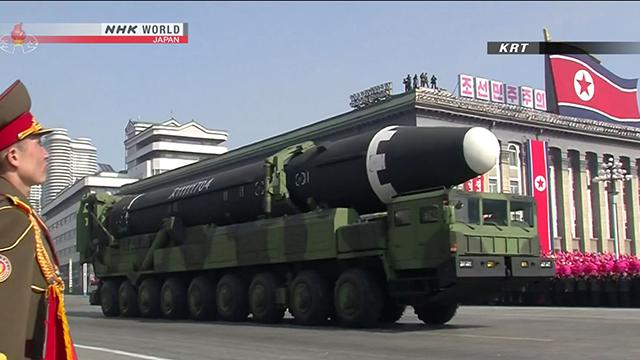On the same day that troops and weaponry were cheered in the streets of Pyongyang, North Korean athletes were welcomed at the Olympic village in Gangneung.
Some athletes were seen wiping away tears while the North Korean anthem played.
The country's female cheerleaders also arrived. At the end of the ceremony, the squad performed a song titled "Happy to see you".
One of its members said she's truly happy to see everyone. She said she feels like she's in the land of the same ethnic group, and that she wants both sides to join hands for reunification.
North Korea has taken a conciliatory stance in the run-up to the PyeongChang Olympics. The North's Sam-jiyon orchestra held its first concert in the South.
Meanwhile in central Pyongyang, North Korea staged a large military parade to mark the 70th anniversary of the foundation of its armed forces.
The country's state-run TV said "heaven and earth were shaken by the passion of the people celebrating the occasion."
North Korea recently changed the military's Foundation Day from April 25th to February 8th. It staged the parade one day before the opening of the Olympic Games in the South.
Leader Kim Jong Un appeared on the balcony along with his wife. He delivered a speech to an estimated crowd of 50,000 people. Kim said today's military review would showcase a nation that has become a world-class military power.
He was defiant toward the United States, saying that while the US and its stooges behave arrogantly near the Korean Peninsula, the Korean People's Army should remain combat-ready and bolster war preparations. He also said they must never allow aggressors to invade the country -- even by a thousandth of a millimeter.
US Vice President Mike Pence arrived in the South on the same day and held talks with South Korean President Moon Jae-in.
Moon said his country wants to make the most of the Olympics and bring North Korea back to the negotiating table in order to achieve a nuclear-free and peaceful Korean Peninsula.
Pence said that the US will continue to stand shoulder to shoulder with the South to put maximum pressure on North Korea until they finally, permanently and irreversibly abandon their nuclear and ballistic missile ambitions.
Pence is believed to have urged Moon not to be misled by North Korea's conciliatory approach and to put more pressure on Pyongyang.
What is the Hwasong-15?
The Hwasong-15 is North Korea's new ICBM-class missile. Pyongyang says the 2-stage, liquid-fuel missile can strike any location on the US mainland.
North Korea tested the Hwasong-15 for the first time last November, firing it from the western part of the country into the Sea of Japan. It was launched at a lofted trajectory, which has a steeper angle than usual. Pyongyang says the missile reached an altitude of 4,475 kilometers, the highest for a North Korean missile, and traveled horizontally for 950 kilometers. It also says the Hwasong-15 can carry a very large and heavy nuclear warhead.
The Hwasong-15 is believed to have considerably greater thrust compared to the Hwasong-14, another ICBM-class missile which was fired in July. The new missile's first stage is powered by 2 engines, while the previous rocket had only one. The mobile launcher for the Hwasong-15 is also larger than other ones in North Korea, with 9 wheels on each side.
North Korean leader Kim Jong Un expressed confidence in his country's missile development program following the Hwasong-15 test. He said his country has achieved the historic feat of completing its nuclear forces.
The South Korean defense ministry says the Hwasong-15 has a range of over 13,000 kilometers and could potentially hit the US capital of Washington. But it adds that further verification is needed on the missile's atmospheric reentry and final-phase precision guidance technology.
US Defense Secretary Jim Mattis said in December that North Korea has yet to show that it is a credible threat to the United States.
Expert: North Korea shows technological achievements in parade
Military analyst Yu Koizumi of the Institute for Future Engineering says North Korea may have wanted to use Thursday's military parade to show off progress in its missile technology.
Koizumi says North Korea displayed four Hwasong-15s in the parade, noting that it managed to produce at least 4 large missiles in a short while since the launch last November. He says this means the country can produce several long-range missiles at a time, not just one at a time for a test-launch.
Koizumi notes the parade did not show any new ICBMs, with Pyongyang instead emphasizing how confident they are in the progress they've already achieved.
Expert: Parade not overly provocative
Toshiyuki Ito, who served as a vice admiral in the Maritime Self-Defense Force, says North Korea's parade is meant to show that the country will not give up its nuclear and missile development despite international pressure.
Ito is now a professor at the Kanazawa Institute of Technology Toranomon Graduate School of Innovation Management. He says North Korea has always invited foreign correspondents to its military parades, but did not do so this time. He says this may mean the North is showing a degree of consideration for the current conciliatory atmosphere between the 2 Koreas.
Ito says Thursday's parade displayed the missiles Pyongyang succeeded in launching last year, including the new ICBM-class Hwasong-15 test-fired in November. But he notes that the parade offered nothing new.
He says the parade was less provocative than usual, meaning the North may be exercising some self-restraint.
